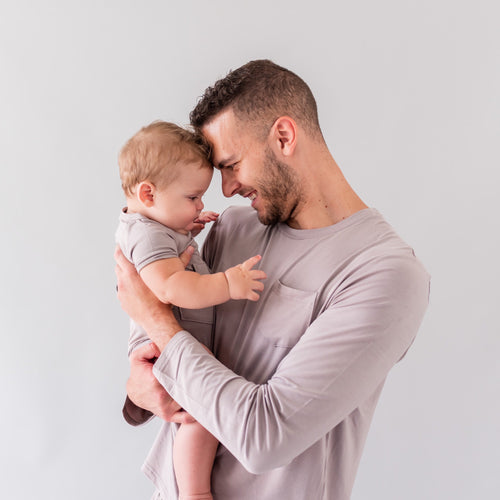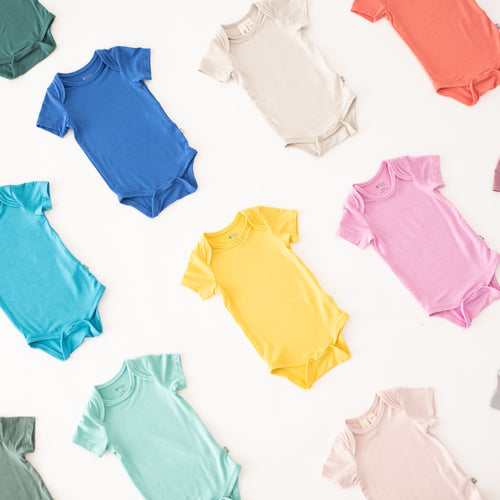One of the biggest conundrums a parent faces when traveling is figuring out where and how their baby will sleep. When you have a baby, a routine isn’t just necessary—it’s a lifeline. At home, the bedtime routine may look like bath, pajamas, nursing/bottle, book, sleep bag, then crib. From reading a book together in your rocking chair to turning on your sound machine to the ocean setting, the routine is rock-solid and inexplicably comforting. So, when you’re staying somewhere that isn’t home, it might seem daunting to figure out your baby’s bedtime accommodations. Obviously, nothing is more ideal than their own crib at home, but there are still plenty of great options that allow you to practice safe sleep on the go. No matter where you are, it’s important to still follow safe sleep guidelines for your baby’s safety. Here’s how you can plan accordingly:
1. USE A CRIB, PORTABLE CRIB, BASSINET, OR PLAY YARD
To make sure that your baby has a safe, separate place to sleep, bring along a portable bassinet or play yard to your travel destination. If you’re flying, this can be inconvenient because these items are bulky, heavy, and also add to checked luggage costs. However, the peace of mind is absolutely worth the hassle. Another option is to call your hotel and find out if you can reserve a crib. Many hotels keep cribs on hand for their guests, but they may not be able to guarantee that one will be available for your stay. Our advice? Bring your own.
Whether you decide to bring a travel crib, bassinet, or play yard, always double check that it meets the safety standards of the Consumer Product Safety Commission (CPSC). Do not bring an inflatable bed or mattress, as these are not designed or safe for infant use. While they’re easier to carry around because they’re lighter and smaller when not inflated, they pose a major suffocation risk to your baby. If you’re staying at someone’s home, you may be sleeping on their air mattress, futon, sofa, or spare soft mattress. None of these are safe for your baby. Bringing your own travel crib, bassinet, or play yard guarantees that your baby has a safe, separate place to sleep.
2. ALWAYS PLACE YOUR BABY ON THEIR BACK TO SLEEP
No matter where you are, your baby should always be placed on their back to sleep. The 1994 Back to Sleep campaign raised awareness for putting babies to sleep on their backs, instead of their sides or stomachs. The campaign was a huge success, reducing the rate of Sudden Infant Death Syndrome (SIDS) by a whopping 60%. That’s a statistic so incredible that it should never be ignored. While the exact reasons that back-sleeping is safer than stomach-sleeping are not entirely known, it is undoubtedly the single most effective action that parents and caregivers can take to reduce their baby’s risk of SIDS. The only problem? Many babies do prefer to sleep on their stomachs, and sleep soundly in that position. When you’re traveling and disrupting your baby’s normal routine, your little one may be more fussy than usual. It may be tempting to give in to whatever helps them sleep faster, but don’t. It’s incredibly important to continue to follow this major safe sleep guideline. However, if your baby is put to sleep on their back, but rolls onto their stomach on their own during sleep, there’s no need to turn them back around.

3. DON’T BED SHARE
Trust us, we know. Nothing is more heartbreaking than hearing your baby cry, and when you’re away from home and in an unfamiliar setting, they may be even harder to settle and have trouble falling asleep. After walking back and forth in your hotel room, making shushing noises until your throat is dry, and rocking your baby until your arms feel like they’ll fall off from exhaustion, the temptation to co-sleep in the big bed is understandable. Few things are more draining than spending the past 45 minutes helping your baby fall asleep, only to have them wake up screaming the second you put them into their crib. Your baby is calmest and happiest when they are in your arms, but the American Academy of Pediatrics still recommends that all babies sleep on their back in a flat, firm, separate sleep surface. Hotel beds are often soft, with giant, fluffy pillows, and puffy comforters. These all make the bed super comfortable for an adult, but incredibly dangerous for a baby. The AAP advises against co-sleeping completely, but that combined with soft, fluffy bedding and a worn-out-from-traveling parent present an even more dangerous situation.
4. FOLLOW THEIR BEDTIME ROUTINE
Since your infant’s usual environment and routine have been disrupted, following their bedtime routine as closely as possible can help them sleep soundly, even if they’re in an unfamiliar sleep space. If your baby’s routine starts with a bath, then a feeding, then a book, then their sleep bag, and then finishes with the crib, you can still follow those steps in that order. Bring along your baby’s favorite books and their familiar sleep bag. The simple act of zipping your baby into their sleep bag becomes a strong sleep cue that can prove majorly useful even when you’re away from home.

5. RECREATE YOUR BABY’S SLEEP SPACE
Remember, nothing but your baby should go in their sleep space. That means no blankets, no soft toys, no crib bumpers, no pillows, and no loveys. Aside from their pacifier (although, it should be noted that pacifiers attached to soft toys are not approved for sleep), your baby should be sleeping alone. The best way to help your infant sleep while traveling is to use the same, familiar items they’re used to at home. Bringing along their favorite sleep bag, crib sheet in the appropriate size (pro tip: our changing pad covers fit many play yard and travel crib mattresses), and sound machine with their usual settings can recreate their familiar environment anywhere you go.














